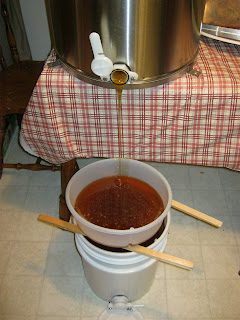I purchased also a stand for it, but I didn't have time to mount the stand on a solid wooden base (that'll be next year's project). So I just set it on the kitchen table like last time. Here's the setup:
First comes the uncapping of the frames. Like last time, I used a simple serrated bread knife. It seems to work, and I don't feel I need a heated knife. I use a rubbermaid container to catch all the cappings.
My youngest son Jacob was anxious to help - he held the extractor body as I spun it, because the frames were off balance a lot.
Liquid gold! I noticed that this time the honey was very dark.
There's always some honey which doesn't come out the spigot - I solved that problem!
Here are the cappings - I strain those to get the honey out and then let the bees clean up the rest.
So here's the take from the fall - around 25 pounds. Not bad! Enough to give as Christmas gifts as well as sell to recoup a little of my investment.
Notice the difference from the spring honey (on the left - very clear) and this fall honey (right - dark and thick). It all depends on the flowers the bees visit.
Here are the cappings set out for the bees to reclaim. I also made a video so you can see the activity. Especially in the fall (when there are no flowers) the bees are anxious to reclaim all of the honey the can!











The honey looks lovely, both light and dark. Do you do anything with your wax cappings?
ReplyDeleteTo this point I've been just saving the cappings. I need to make a solar melter and melt them down. I have a couple of gallon zip-loc bags of wax (cleaned by the bees) from cappings...
ReplyDelete